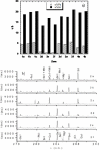Laser induced breakdown spectroscopy for elemental analysis in environmental, cultural heritage and space applications: a review of methods and results
- PMID: 22163611
- PMCID: PMC3231154
- DOI: 10.3390/s100807434
Laser induced breakdown spectroscopy for elemental analysis in environmental, cultural heritage and space applications: a review of methods and results
Abstract
Analytical applications of Laser Induced Breakdown Spectroscopy (LIBS), namely optical emission spectroscopy of laser-induced plasmas, have been constantly growing thanks to its intrinsic conceptual simplicity and versatility. Qualitative and quantitative analysis can be performed by LIBS both by drawing calibration lines and by using calibration-free methods and some of its features, so as fast multi-elemental response, micro-destructiveness, instrumentation portability, have rendered it particularly suitable for analytical applications in the field of environmental science, space exploration and cultural heritage. This review reports and discusses LIBS achievements in these areas and results obtained for soils and aqueous samples, meteorites and terrestrial samples simulating extraterrestrial planets, and cultural heritage samples, including buildings and objects of various kinds.
Keywords: Laser Induced Breakdown Spectroscopy (LIBS); cultural heritage; elemental analysis; meteorites; optical emission; soils; space exploration.
Figures






Similar articles
-
Heavy metal concentrations in soils as determined by laser-induced breakdown spectroscopy (LIBS), with special emphasis on chromium.Environ Res. 2009 May;109(4):413-20. doi: 10.1016/j.envres.2009.02.005. Epub 2009 Mar 9. Environ Res. 2009. PMID: 19272593
-
Evaluation of laser induced breakdown spectroscopy for multielemental determination in soils under sewage sludge application.Talanta. 2011 Jul 15;85(1):435-40. doi: 10.1016/j.talanta.2011.04.001. Epub 2011 Apr 8. Talanta. 2011. PMID: 21645722
-
The Plasma Spectroscopic Study of Dergaon Meteorite, India.Molecules. 2020 Feb 22;25(4):984. doi: 10.3390/molecules25040984. Molecules. 2020. PMID: 32098386 Free PMC article.
-
Laser-induced breakdown spectroscopy application in environmental monitoring of water quality: a review.Environ Monit Assess. 2014 Dec;186(12):8969-80. doi: 10.1007/s10661-014-4058-1. Epub 2014 Sep 26. Environ Monit Assess. 2014. PMID: 25255856 Review.
-
Prospects for laser-induced breakdown spectroscopy for biomedical applications: a review.Lasers Med Sci. 2011 Sep;26(5):673-87. doi: 10.1007/s10103-011-0921-2. Epub 2011 Apr 28. Lasers Med Sci. 2011. PMID: 21533560 Review.
Cited by
-
Laser Spectroscopic Sensors for the Development of Anthropomorphic Robot Sensitivity.Sensors (Basel). 2018 May 23;18(6):1680. doi: 10.3390/s18061680. Sensors (Basel). 2018. PMID: 29882902 Free PMC article.
-
New Approach for Near-Real-Time Measurement of Elemental Composition of Aerosol Using Laser-Induced Breakdown Spectroscopy.Aerosol Sci Technol. 2012;46(3):316-332. doi: 10.1080/02786826.2011.625059. Epub 2011 Oct 12. Aerosol Sci Technol. 2012. PMID: 26692632 Free PMC article.
-
Fabrication of a Low Cost Superhydrophobic Substrate for Surface Enhanced Laser-Induced Breakdown Spectroscopy and Its Utility through Identification of Electrolyte Variation for Oral Cancer Detection.ACS Biomater Sci Eng. 2024 Feb 12;10(2):1153-1161. doi: 10.1021/acsbiomaterials.3c01275. Epub 2024 Jan 16. ACS Biomater Sci Eng. 2024. PMID: 38227930 Free PMC article.
-
Importance of laser-induced breakdown spectroscopy for hard tissues (bone, teeth) and other calcified tissue materials.Lasers Med Sci. 2015 Aug;30(6):1763-78. doi: 10.1007/s10103-014-1549-9. Epub 2014 Feb 26. Lasers Med Sci. 2015. PMID: 24570087 Review.
-
Laser-Induced Breakdown Spectroscopy: An Efficient Tool for Food Science and Technology (from the Analysis of Martian Rocks to the Analysis of Olive Oil, Honey, Milk, and Other Natural Earth Products).Molecules. 2021 Aug 17;26(16):4981. doi: 10.3390/molecules26164981. Molecules. 2021. PMID: 34443568 Free PMC article. Review.
References
-
- Brech F, Cross L. Optical Microemission Stimulated by A Ruby Laser. Appl. Spectrosc. 1962;16:59.
-
- Radziemski LJ. From LASER to LIBS, the Path of Technology Development. Spectrochim. Acta B. 2002;57:1109–1113.
-
- Fantoni R, Caneve L, Colao F, Fornarini L, Lazic V, Spizzichino V. Methodologies for Laboratory Laser Induced Breakdown Spectroscopy semi-Quantitative and Quantitative Analysis—A Review. Spectrochim. Acta B. 2008;63:1097–1108.
-
- Tognoni E, Palleschi V, Corsi M, Cristoforetti G. Quantitative micro-Analysis by Laser-induced Breakdown Spectroscopy: A Review of the Experimental Approaches. Spectrochim. Acta B. 2002;57:1115–1130.
-
- De Giacomo A, Dell’Aglio M, De Pascale O, Gaudiuso R, Teghil R, Santagata A, Parisi GP. ns- and fs-LIBS of Copper-based-Alloys: A Different Approach. Appl. Surf. Sci. 2007;253:7677–7681.
Publication types
MeSH terms
Substances
LinkOut - more resources
Full Text Sources
Other Literature Sources

